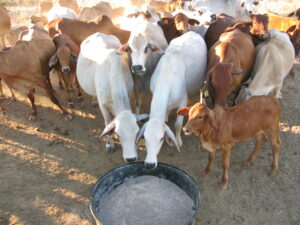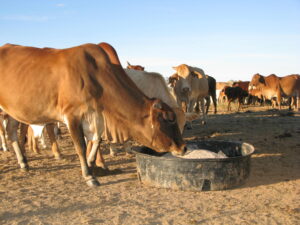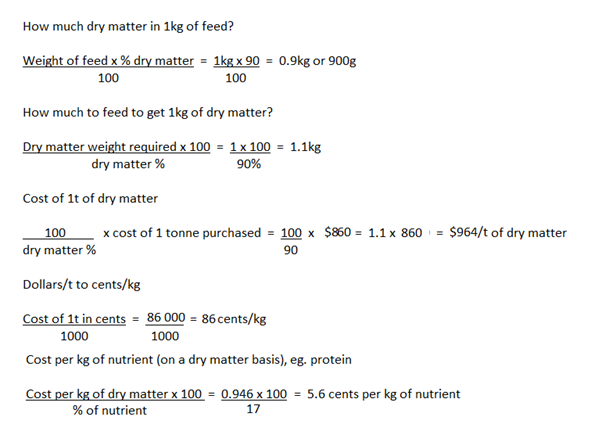Costing supplements
 When deciding on a supplement strategy, it is important to determine the cost of the supplement in relation to the nutrient you require. In some cases, the supplement that appears to be the dearest may actually be the cheapest per unit of nutrient.
When deciding on a supplement strategy, it is important to determine the cost of the supplement in relation to the nutrient you require. In some cases, the supplement that appears to be the dearest may actually be the cheapest per unit of nutrient.
Before starting supplementation
Before starting a wet or dry season feeding regime, it is important to identify if your herd is deficient. Soil testing or P-screening via your vet or local extension officer will determine phosphorus (P) deficiency. Faecal NIRS testing will determine if feeding a urea supplement would be beneficial to reduce weight loss (see Assessing pasture diet quality).
Research indicates the expense of wet season P feeding in deficient, to acutely deficient country, is worthwhile with a significant return on investment (see Kidman Springs supplementation trial). Dry season supplementation may not be avoidable, but expense can be minimised through pregnancy testing and segregation of breeders to allow targeted supplementation of at risk groups. Keeping breeders in a body conditions score of 2.5+ at weaning and maintaining a good supply of pasture will reduce excessive supplement costs through the dry season.
Wet season supplements
In northern Australia, the majority of country is deficient in phosphorus (see Phosphorus supplementation of cattle in northern Australia). It is ideally fed from the beginning of the wet season when pasture is green and P is the most limiting nutrient, rather than protein or energy as during the dry season. Producers must determine which is the most cost-effective way to feed P as there are numerous products on the market with different P contents.
For example, comparing the following supplements:
- 8% P block at $1200/tonne delivered
- 10% P loose lick at $980/tonne delivered
- 12% P block at $1400/tonne delivered
To determine the cost of the nutrient required, in this case P, we calculate how much of the supplement must be consumed to reach the required target intake. In P deficient country, a target of 10g P/hd/day is assumed for a breeder/calf unit.
Calculate how much must be consumed to reach target intake
(phosphorus required ÷ phosphorus content % in supplement) x 100
For example
- 8% P block: (10g ÷ 8 per cent in supplement) x 100 = 125g/hd/day
- 10% P loose lick: (10g ÷ 10 per cent in supplement) x 100 = 100g/hd/day
- 12% P block: (10g ÷ 12 per cent in supplement) x 100 = 83g/hd/day
Calculate the daily cost per head of the supplement to supply this nutrient
(cost per tonne x daily supplement intake (kg)) ÷ 1000kg
For example
- 8% P block at $1200/t: ($1200 x 0.125kg/hd/day) ÷ 1000 = $0.15 or 15 cents/hd/day
- 10% P loose lick at $980/t: ($980 x 0.100kg/hd/day) ÷ 1000 = $0.098 or 9.8 cents/hd/day
- 12% P block at $1400/t: ($1400 x 0.083kg/hd/day) ÷ 1000 = $0.116 or 11.6 cents/hd/day
These examples indicate that while the 8% block is cheaper per tonne, it is more expensive than the higher P content block in terms of required daily intake. The loose lick is the cheapest option in this example.
 Dry season supplements
Dry season supplements
When diet quality declines in the dry season, a protein supplement will reduce weight loss in animals. A target protein intake of 150g/hd/day for a breeder/adult equivalent and 75/g/hd/day for a dry/growing animal is used. To identify the most cost-effective dry season supplement, we calculate the required daily intake and cost per head per day based on the protein content in the mix. There are various forms of supplying protein in the dry such as the examples below.
For example, comparing the following supplements:
- Dry season urea block, 86% crude protein at $1250/t delivered
- Breeder loose mix, 96.4% crude protein at $770/t delivered
Calculate how much of the supplement must be consumed to reach target intake
(protein required ÷ protein content % in supplement) x 100
For example
- Dry season urea block 86% crude protein, fed to breeders: (150g ÷ 86) x 100 = 174g/hd/day target intake
- Breeder loose mix, 96.4% crude protein, fed to breeders: (150g ÷ 96.4) x 100 = 156g/hd/day target intake
To calculate the daily cost per head of the supplement to supply this nutrient
(cost per tonne x daily supplement intake (kg)) ÷ 1000kg
For example
- Dry season urea block (86% crude protein) at $1250/t delivered, fed to breeders:
($1250 x 0.174kg) ÷ 1000 = $0.217 or 21.7 cents/hd/day
- Breeder loose mix, 96.4% crude protein at $770/t delivered: ($770 x 0.156kg) ÷ 1000 = $0.12 or 12 cents/hd/day
In this case, the loose lick is the cheaper option due to price and less required intake. While every effort can be made to use the most cost-effective supplement, the most important factor is whether the animals are physically eating enough to reach their target intakes. Closely monitor intakes and adjust the recipe, if possible, or consider alternative products if intake is either too high or too low.
As lick blocks and loose lick supplements are almost 100% dry matter, we do not need to take into this account the amount of moisture present when calculating cost or nutrient consumption. In contrast, the percent dry matter would need to be taken into account when costing feed components such as silage, grains, whole cotton seed, or molasses.
Calculations for cost of dry matter and nutrients
Lick labels can express nutritional value as either ‘as fed’ or on a ‘dry matter basis’. The following calculations demonstrate how to work out the cost in dry matter format. In this example, palm kernel expeller is used as an example of providing protein in a dry season supplement:
Palm kernel expeller
- Dry matter: 90%
- Price: $860/t
- Protein: 17%
- Energy: 11.7MJ ME/kg
Written by Russ Tyler, formerly Queensland Government. Reviewed and edited by Eloise Moir, Megan Munchenberg and Bernie English, Department of Agriculture and Fisheries.
This document was reviewed as part of the GrazingFutures Project. GrazingFutures is funded by the Queensland Government’s Drought and Climate Adaptation Program (DCAP) that aims to build drought and business resilience for Queensland livestock producers.
For more information
Product labels – What are they saying? →
Nutrient composition of feeds →
Or, attend a Nutrition EDGE workshop →
For help reviewing your supplement strategy, get in touch with your local beef extension officer.
